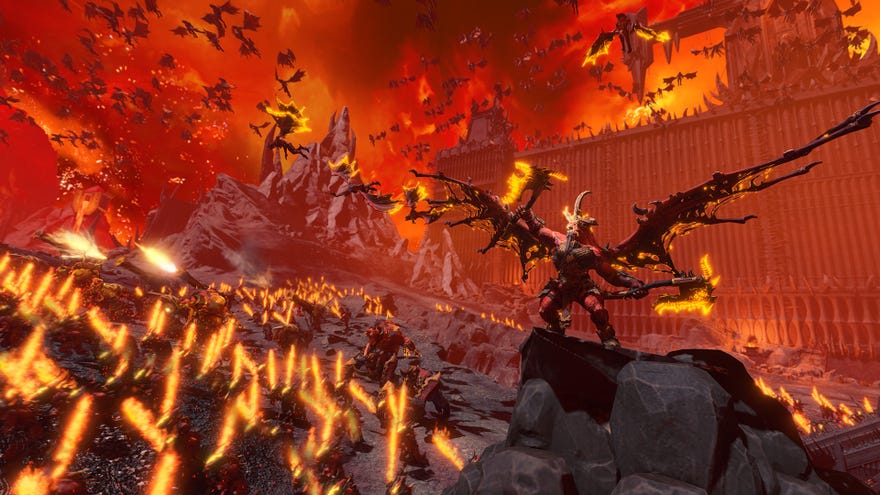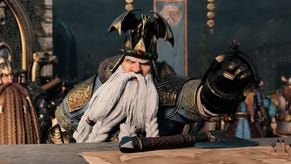An absolute beginner’s guide to getting started with Total War: Warhammer and Immortal Empires
Plus what DLC to buy first depending on your favourite faction
The Total War: Warhammer series is big. You just won't believe how vastly, hugely, mind-bogglingly big it is. Luckily, coming up with completely original quotes is not my only skill. I’ve also become very adept at pouring hundreds of hours into this series of strategy games. The aim of this guide is to save you some time, and give some tips on what they’re all about.
For my money, they’re the best Total War games available, but they’re also very dense and a bit complicated to get started with. I’m hoping this will stand as a comprehensive one-stop beginner’s guide for anyone looking to jump into the series for the first time, without getting too bogged down with the details. Included is an exhaustive list of which DLC to buy depending on what faction you like the look of the most, since navigating the expansions can sometimes feel more complicated than the game itself. Onward!
In this guide:
- What is Total War: Warhammer?
- What DLC to buy for Total War: Warhammer
- Your first turns in Total War: Warhammer
- General tips for your first few turns and beyond
What is Total War: Warhammer?
Simply put, Total War: Warhammer is a series of strategy games set in the world of Warhammer Fantasy, a tabletop wargame setting some enterprising British blokes came up with in the eighties so they’d have a paycheque’d excuse to paint more wizards. The Total War series is notable because it actually combines two different genres of strategy game into one, which I’ll refer to as the campaign map and the battles.
Campaign Map
The campaign map is a zoomed-out representation of the entire Warhammer world, divided into provinces and settlements, each of which is controlled by a different faction. You can think of this part as a very elaborate board game. It’s here you’ll make decisions on how to run your empire, research technologies, upgrade your settlements, play with your economy, recruit your troops, level up your characters, take territory from your enemies, make deals with your allies, and control your armies.
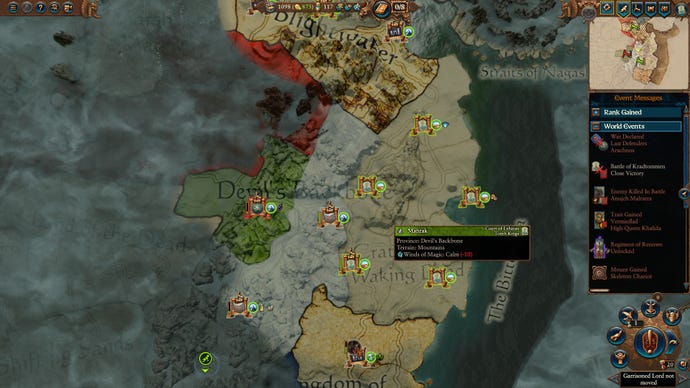
You’re not under any sort of pressure or time limit during all this, so you can take as long as you want to make your choices and figure out what to do next. After you’re done making all your decisions, you end your turn, then everyone else on the map takes theirs. There’s no turn limit for the game, although the longer the game progresses, the stronger your surviving enemies will become, simply because they’ll be doing the same things that you are: research, recruiting armies, levelling up characters, and upgrading settlements.
Sometimes, two armies engage in battle by meeting each other on the campaign map, and the game turns into the other type of strategy game: the extremely violent type. Yay!
Battles
Broadly speaking, battles in the Total War games are real-time strategy, or RTS. You set up your army in whatever formation you choose and start the battle. After that, all your units move and attack as soon as you tell them to.
While RTS like Starcraft or Warhammer 40,000: Dawn Of War divide units into individuals, Total War uses formations. So the equivalent of one Terran marine in Starcraft might be a big block of 120 elf archers in Total War: Warhammer. There are still individuals, like army commanders and the odd giant or dragon, but you’ll mainly be commanding units as the formations.
While you can pause, issue commands, and unpause at any time, the standard flow of a battle is usually quite fast paced, and you’ll often want to be constantly making decisions on-the-fly to outmanoeuvre your enemy, or try to force them into suboptimal positions.
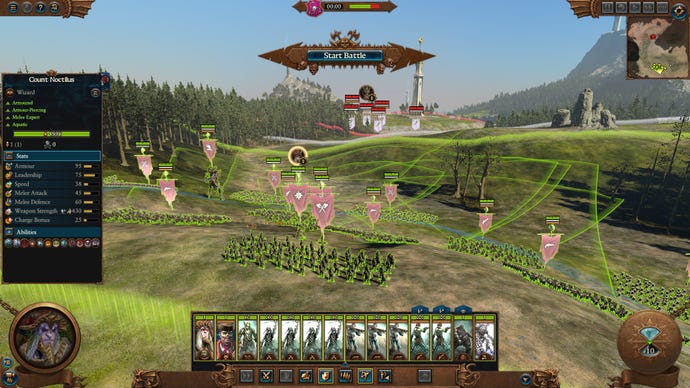
A classic example of this is known as ‘Hammer and Anvil’. This is where you lock the enemy’s frontline units in melee combat with your own, then use cavalry or other fast moving units to run behind them and charge into their unprotected flanks or rear. Things like positioning and flanking have big effects on morale and defence in Total War, so this sort of thing is extremely effective. Most of the time, you aren’t even necessarily trying to wipe out the enemy army - you’re just trying to freak them out enough that they run away.
There are lots of other factors to consider: can the unit of goblins I’m sending to attack this throng of heavily-armoured dwarfs actually pierce through their armour? Am I wasting this spell on a unit with a high resistance to magic? Do I really want to charge my calvary into that battle line when there’s a unit of spearmen waiting to counter-attack? As I said above, though, you’ll pick most of this stuff up as you play, and most of it is quite intuitive anyway. If you think a tactic might work in a real battle, there’s a fair chance it’ll work in Total War.
Setting
Warhammer Fantasy is what would happen if you put every conceivable fantasy trope together on a single planet and made them all very angry with each other. Also, all the tropes are the silliest version of themselves. It’s a bit Lord Of The Rings and a bit Monty Python. It’s got magic and gods and dragons and feudalism and taxes, but it’s also got Arthurian knights facing off against giant mad scientist rats.
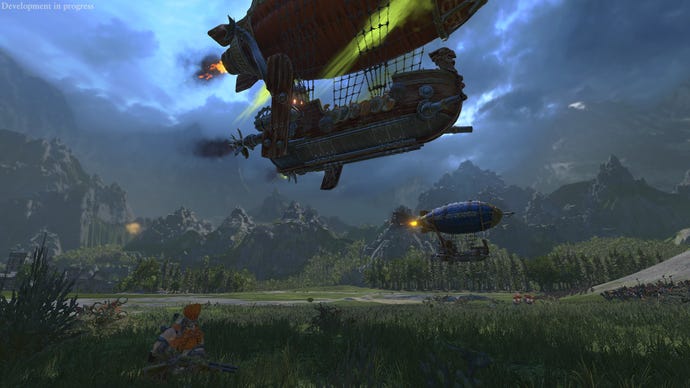
What DLC to buy for Total War: Warhammer
The Total War: Warhammer series has 21 pieces of paid DLC across 3 separate main games, alongside dozens of free lords, heroes, and other updates. Put simply, it’s a confusing mess for a new player. To make things easier, I’ve created a list below, based on the only question you should ask yourself when it comes to which expansions to buy and which to skip: what faction do I think is the coolest and would have the most fun playing? First, a few important tips to keep in mind:
- The only main entry in the series you absolutely need to purchase in order to play the newest and best version of Immortal Empires (the massive sandbox map that most people are talking about when they talk about playing the game) is Total War: Warhammer 3. At the time of writing, it’s 50% off on Steam. This is also its lowest recorded price so far.
- You make two decisions before you start any campaign: which faction to play as, and which legendary lord (hereafter just lord) to command. Dwarfs, Lizardmen, and The Empire are all factions. Malakai, Mazdamundi, and Karl Franz are all lords. Every faction has multiple lords, but lords can’t belong to multiple factions.
- Even without any DLC, the Warhammer 3 base game lets you play Immortal Empires as some (but not all) lords from the following factions: Kislev, Cathay, Khorne, Slaanesh, Nurgle, Tzeentch, Daemons of Chaos, and Warriors of Chaos. You’ll also be able to play as any of the four Bretonnian lords, since they’re all free. Although, as with much of the trilogy’s free content, you will need to connect your Steam account to Creative Assembly’s website.
- You’ll also be able to play a story-based tutorial and the narrative Realms of Chaos campaign, which is worth doing at least once.
- Whether you own no DLC, or every piece of DLC, the world you’ll be playing Immortal Empires in will be identical. You’ll still encounter every faction in the game, and still face off against every new lord, unit, and spell. Put simply, you’ll always have access to the most up-to-date version of the game, you just won’t be able to play with all the toys yourself, either in campaign, multiplayer, or custom battle.
- It used to be that if you wanted the base roster for an older faction that first appeared in a mainline numbered game - e.g The Empire or Lizardmen - you’d need to buy the game they first appeared in. Now, if you own Warhammer 3, you just need to buy any DLC pack for the faction you want, and you get access to that DLC’s lord, the base roster of units from the mainline game that faction first appeared in, and any and all ‘FreeLC’ lords released for that faction.
What should I buy first if my favourite faction is:
- Beastmen: Buy The Silence & The Fury. You’ll get the best Beastmen campaign with Taurox the Brass Bull, and full access to the roster. You’ll even get to play as the other Beastmen legendary lords later in the campaign as part of the faction’s unique recruitment mechanics
- Dwarfs: Buy Malakai, and you’ll also get access to Grombindal the White Dwarf, and Throrek Ironbrow. That’s the three most interesting Dwarf campaigns for the price of one, and most of their roster. If you want to round out the roster with some fun but less essential units, buy The King & the Warlord next.
- The Empire: Buy the first Total War: Warhammer if you want the classic Karl Franz experience, or Elspeth if you want some absolutely ridiculous magic-infused gunlines. Either way, you’ll get Balthasar Gelt for free. He’s supreme, I hear.
- Greenskins (Orcs and Goblins): Buy The Warden & The Paunch. You’ll get access to Grom The Paunch, the most fun Greenskin campaign. You’ll also be able to play as Azhag the Slaughterer and Wurrzag da Great Green Prophet, and you’ll get access to most of the Greenskin roster. If you want to round out your collection with extra squigs, you’ll want to buy The King & the Warlord next.
- Vampire Counts: Buy the first Total War: Warhammer.
- Warriors of Chaos: This is the mortal side of the Chaos roster, mainly consisting of dudes in armour. You’ll want to buy The Champions Of Chaos, and this will synergise nicely with the daemonic roster already found in Warhammer 3’s base game.
- Nurgle: You’ll get a good chunk of the roster in Warhammer 3’s base game, and you can round out your forces with Tamurkhan.
- Tzeentch: You’ll get a good chunk of the roster in Warhammer 3’s base game, and you can round out your forces with Shadows Of Change. I’d recommend just playing the base game Tzeentch first, though, to make sure you like the faction before buying what’s quite an expensive expansion for the content.
- Slaanesh: Warhammer 3 base game.
- Khorne: Warhammer 3 base game. There’s a free dog too.
- Wood Elves: Buy The Twisted & The Twilight.
- Norsca: Buy Norsca.
- Lizardmen: If you want a bunch of lords for Lizardmen, Dark Elves, High Elves, and Skaven all bundled together, buy Total War: Warhammer 2. Otherwise, buy The Silence & The Fury. You’ll get a fun, experimental Lizardmen campaign with Oxyotl, plus two more traditional campaigns for free with Gorok and Tiqtak’to.
- Dark Elves: Buy Total War: Warhammer 2, and you’ll get a whopping six Dark Elf lords to choose from, including the excellent Rakarth, voiced by Ramsay Bolton from Game Of Thrones.
- High Elves: This is a slightly tough one, because both DLCs that feature the High Elves include key units for their rosters, but the Total War: Warhammer 2 base game comes with Tyrion - the quintessential high elf experience and one of the best beginner campaigns in the game. For a single pick, I’d say go with Total War: Warhammer 2, and you’ll also get Teclis, Alith Anar and Imrik’s campaigns. Two vanilla campaigns, and two more creative, experimental ways to play.
- Skaven: For a long time, The Prophet & The Warlock was an essential purchase for Skaven players. While it’s still a key DLC for huge parts of the roster, it really comes down to which rat is your favourite. If you want machine guns, nuclear missiles, and other death contraptions, get that one. If you prefer horrible, sewn-together beasties and unnatural biological experiments, get The Twisted & The Twilight. Either way, you’ll also get top-quality meme-rat Tretch Craventail for free.
- Tomb Kings: Only one option. You’ll want Rise Of The Tomb Kings. Make sure to find the free Bone Giant download, too.
- Vampire Coast: Only one option. You’ll want Curse Of The Vampire Coast.
- Ogre Kingdoms: Again, one option, helpfully called Ogre Kingdoms.
- Chaos Dwarfs: Once more, an easy choice. Buy Forge Of The Chaos Dwarfs.
- Kislev: No need for DLC, you’ll get most of the good stuff with base Warhammer 3. Grab Shadows Of Change if they’re your absolute favourites, but it’s not a necessity.
- Grand Cathay: Same again. You’ll get the majority of the roster with base Warhammer 3. Again, grab Shadows Of Change, but only if you’re really into Cathay, or it doubles up with another faction you like.
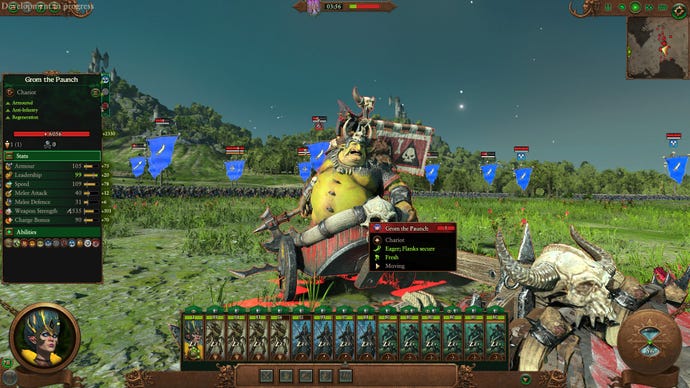
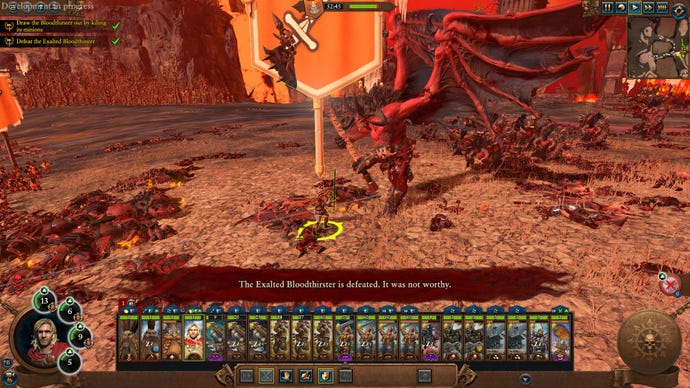

Other things to keep in mind before starting a campaign
- Do you like blood? Sadly, that’ll cost you. If you want blood, gore, and a few unique dismemberment animations in battle, you’ll want to pick up Blood For The Blood God 3. I know. I know.
- Difficulty is somewhat modular, but comes down to two broad choices. 'Battle difficulty' is how many stat buffs the enemy gets. Set this to 'normal' for your first game. 'Campaign difficulty' is, broadly, how many economy cheats the enemy get. Either set this to 'normal' or 'hard'. I actually recommend 'hard', since you’ll get into better habits in the long run. Stick with 'normal' if this is your first time playing a strategy game. Also, if you ever hear anyone shaming anyone else about difficulty in this game, you can safely write them off as a muppet.
- Set advice frequency to ‘high’. Make sure the ‘enable endgame scenarios’ box is unchecked. Leave everything else on default.
Your first turn in Total War: Warhammer
There’s a full tutorial alongside the short narrative campaign in the game. You should absolutely play this first, and I won’t be going over things like controls and menus too much here. Instead, I’ll walk through your first few turns with the game, and try to get you set up for success with some tips. This is just the way I play, though. There are many different viable approaches and strategies, and each faction has its own unique systems and considersations. Don't be afraid to experiment!
We’ll start our first campaign with Katarin of Kislev, since you’ll all have access to her campaign just by buying the Total War: Warhammer 3. Kislev are a hardy, Slavic-inspired human faction. They act as the bulwark of humanity against the forces of chaos encroaching from the north, and worship a bear god. Also, Katarin is voiced by Lae'zel actress Devora Wilde!
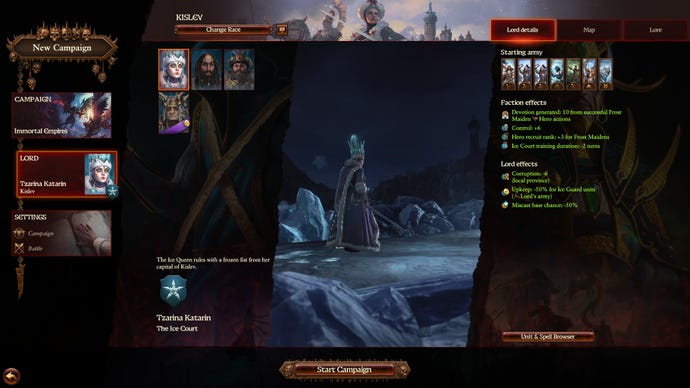
First up, find the research menu through the quill icon in the bottom right corner. The game will warn you about this at the end of the turn, but I like to get it out of the way.
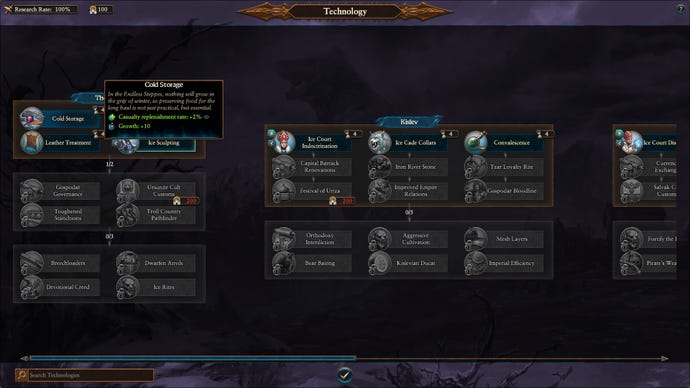
Every first turn features an introductory battle nearby with a warring faction, and you’ll always want to fight this. Before this, however, we’re going to want do a couple of Kislev-only faction specific things.
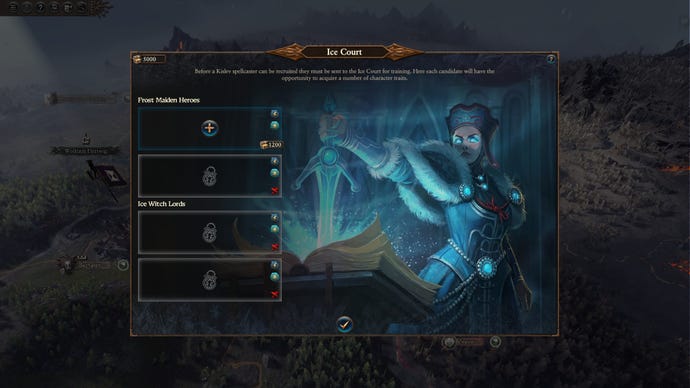
First, click on the crown in the bottom right hand corner to bring up the Ice Court menu, and start training a Frost Maiden hero. Heroes are powerful units you’ll want in your armies, and starting this process early is useful. You’ll notice it costs 1200 gold, which seems like a lot, but we start with a large stockpile and there aren’t that many opportunities to spend it in the early turns.

Next, click on the palace icon on the top middle on the screen to bring up The Motherland menu, and pick whichever of the four options you like the sound of. I like ‘Salyak’ because of the growth and replenishment, but it's up to you. The other bonus here is a resource called 'supporters', although they aren't very relevant until much later in your campaign, so don't worry too much about them now.
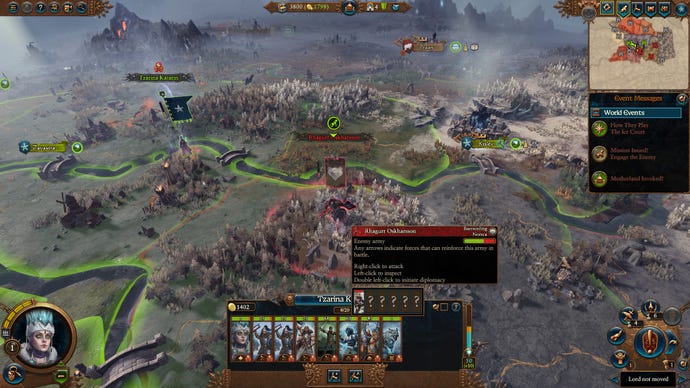
Before the battle starts, you’ll see three options at the bottom of the screen. Autoresolve, fight, and retreat. Fight does what you’d expect. Retreat cancels the fight. and Katarin will move away from the army on the campaign map. Autoresolve calculates the battle results for you in a few seconds, and will give you a result close to the one specified after ‘Battle Result:’. A ‘close victory’ means we’ll win but take quite a few losses. We don't want that. Also, you paid for fighting, not mathing. Click the middle button with the crossed swords.
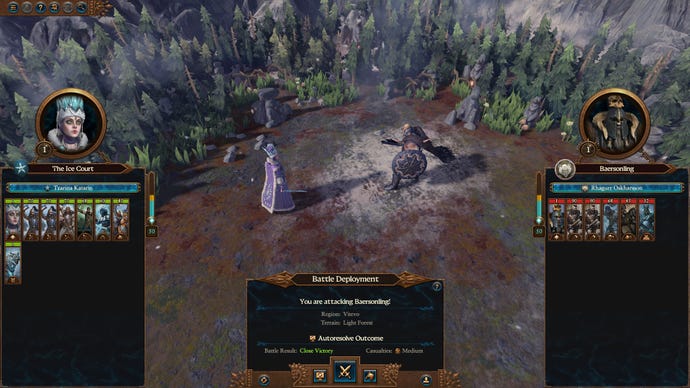
Before the battle starts, you can do two things. First, you can gamble your available magic points for a chance at a few more. Secondly, you’ll be able to organise your army. The very basic idea here is this: melee troops at the front, ranged troops at the back, calvary or fast moving units on the flanks. As for your lord, it depends. Katarin is a spellcaster, so we’re going to keep her away from the frontline for now.
As an additional tip, remember to keep some space between your units rather than making solid, unbroken battle lines. This has a number of advantages, like letting you cover more space, making certain spells less effective, and giving your ranged units more manoeuvrability and better lines of sight. When you’re ready, start the battle.
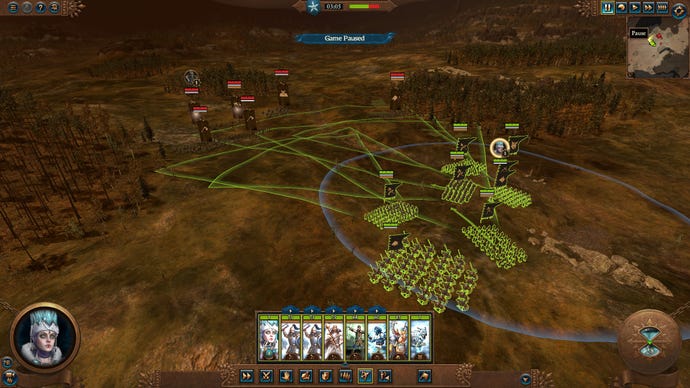
The enemy have decided to stay still, since I have the range advantage. That’s fine. I drag a box around my whole army to select them, then hold alt+shift to keep formation, and move them up the field. Then, I click the speed button at the bottom to make sure they aren’t running. This will cause fatigue, and they'll fight worse. If you find watching the army march across the field gets a bit too slow for you, you can speed things up in the top right corner. But do make sure to go back to normal speed, or even pause, when the action starts.
When the enemy army are just in range of my cones, I stop. You’d usually want to wait until they’re a bit closer to start firing, since missiles lose some effectiveness at maximum range, but this battle won’t last long enough to need to worry about running out of ammunition.

I’m also going to use Katarin’s Ice Sheet spell, slowing down the approaching army and hopefully letting us get a few more shots off. As they close in, I have my ranged units focus fire on the ice trolls, since that’s their most dangerous unit.
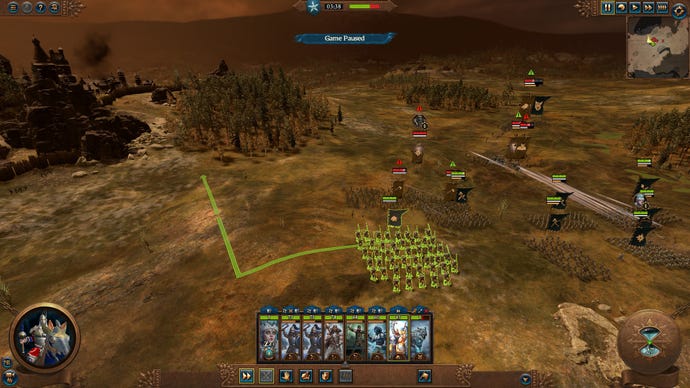
In my haste, I’ve waited too long to set up my calvary, so I hold shift to set a movement path. This will pull them out of danger, and set them up for a rear-charge in a little while.

As the enemy clumps up, I use Katarin’s other spell to deal some damage. You’ll need to set the direction on the spell cone yourself. Make it count!

Even though these trolls are running off, they’ll come back soon once they rally. Worse, trolls have regeneration, so they’ll also get some health back. I continue shooting at them to deal more damage, then send my horses to chase them. As long as a retreating (pale flag) unit is being chased by another, they can’t rally and return to the fight. Also, I got my cat beaten up. Just ignore that.

Ah, the bullets did their job! You’ll notice a skull above the troll’s banner. That means they won’t come back, and we don’t have to worry about them any more. I use my horses to sweep their back lines instead, wiping out their ranged units and chasing down any stragglers. Remember - the more enemy models you kill, the more gold and experience you'll gain from the fight.
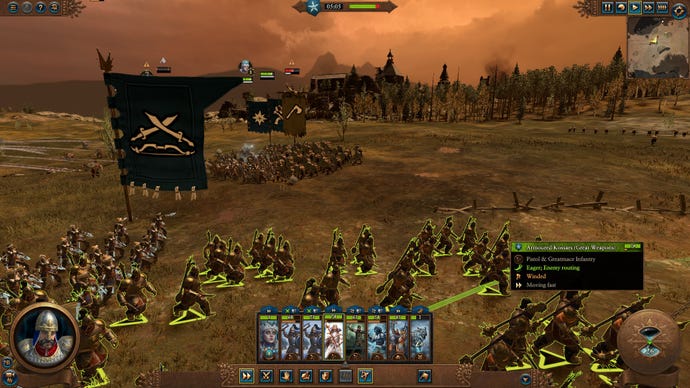
I bring my archers around the side of this enemy unit to help my melee lads out. And soon, the entire army breaks and runs off. We’ve won!
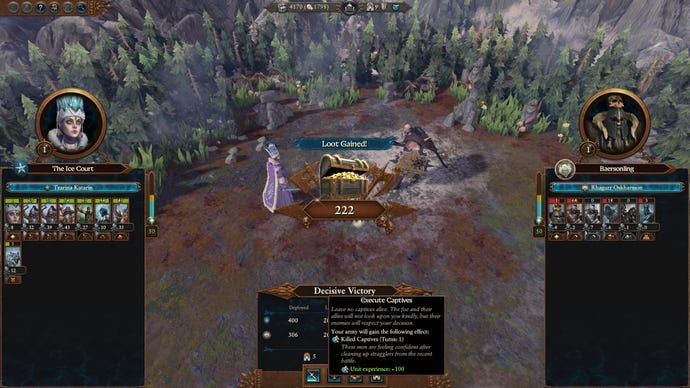
After battle, we’ve got a few different options to choose from. I grab the replenishment to apologise to my neglected cat. I am so sorry, my cold friend.

After battle, Katarin’s got enough experience to gain a skill point. ‘Route marcher’ is the mandatory first pick in almost all situations, so grab that first.
Next up, you’ll attack the nearest enemy settlement. You can either auto resolve this or fight the battle, although I’d recommend getting the practise in. We plan on keeping this settlement, so occupy it. With settlements you might not want to keep later, you can sack them first. This will give you a nice cash bonus but make the actual settlement less useful to own
We get another skill point, so lets put it into Katarin’s magic skill tree. Spells can really turn the tide of battle, so having a powerful caster is a great way to make an average army perform much better than normal. You'll also notice we got some swanky magic armour. This will equip on to Katarin automatically, but you can give it to another lord or hero later.

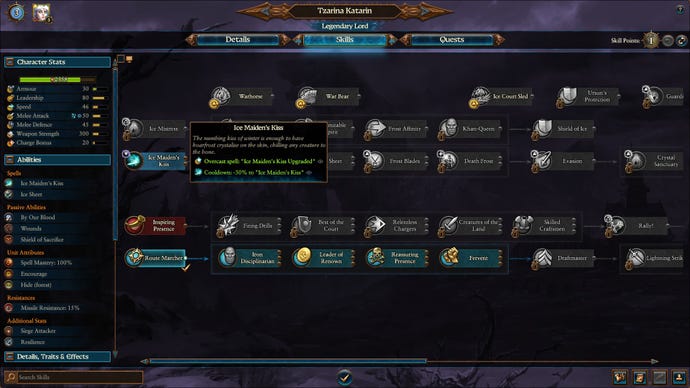
Next up, it’s time to do some building. The basic order of building priority to keep in mind is growth, then economy, then military. First, get as much growth bonus as you can, then focus on getting more money, then build structures that let you recruit new units. With your lords and heroes, the basic units available at the start of the game will be just fine for capturing your first few provinces. Don’t cripple your economy by trying to chase the powerful stuff straight out of the gate, and you won’t have access to most of it for a while anyway.
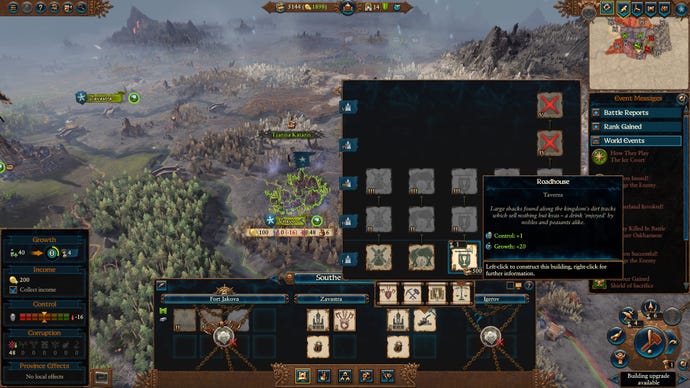
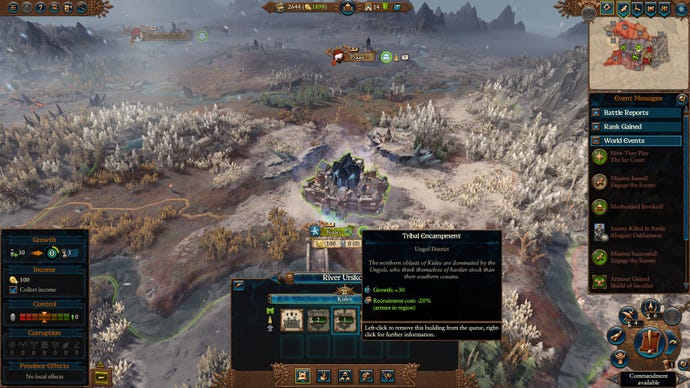
There’s two more things we need to do before hitting the end turn button. First, you’ll notice a notification in the bottom right corner that you have a ‘commandment available’. This means you own an entire province, and can set a bonus for that province. Usually, a province consists of multiple individual settlements, but the city of Kislev itself also counts as an entire province.
Choose ‘Purge the Steppes’, which gives the province a bonus to public order. This prevents rebellions, but more immediately, the higher your control, the bigger bonus to growth you get. Alongside the growth bonus buildings we built, plus the special Motherland edict, plus the research, we’re stockpiling growth very fast. This gives us a huge headstart.
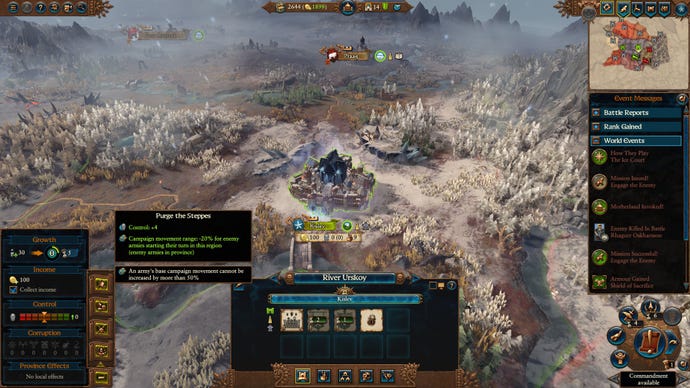
The final thing we’ll do this turn is recruit a second lord. Later, he’ll lead his own army. For now, though, we’ll just send him to tail Katarin and reinforce her in battle, meaning he’ll build up experience points. There’s also some other tricks you can do with this extra lord, like preventing city garrisons from reinforcing nearby armies by sieging their cities, but don’t worry about this for now!
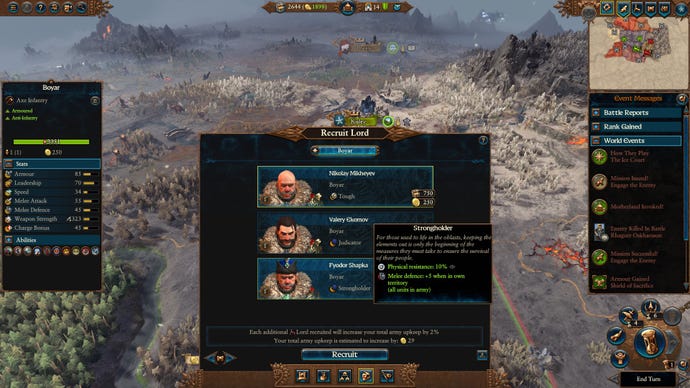
And that’s it! That’s our first turn sorted. Apply these tips going forward, plus the more general tips below, and you’ll be well on your way to being an unstoppable force in the Warhammer world!
General tips for your first few turns and beyond
- ABK (Always Be Krumping): There is little to no advantage to ever playing passively in Total War: Warhammer. While you don’t want to rush to take new territory too quickly because of public order and defensive considerations, you do always want to be working out where your next fight is. If you can’t find it, just go sack an enemy settlement a few times. Fights mean experience and money, and each lord has game-defining abilities at a certain point in their skill tree. Get to fighting!
- Spend your gold: Similarly to the first point, money in Total Warhammer is only really useful as a means to be better at fighting. While it’s worth keeping a bit of a stockpile, in case you need to raise an army in a hurry, you should look to spend your gold as soon as you get it, or else know exactly what your going to spend it on as soon as you have enough.
- Army composition: While you may be a fan of the many flavours of melee infantry in the game, these usually aren’t the troops that are going to win you battles. Make sure you include lots of ranged troops, and a few fast movers and heavy hitters, in every army. Also, make sure every army has at least one spellcaster in it, whether that’s a lord or a hero. Magic is available to every faction (except Khorne!) and not taking advantage of it is just leaving a critical part of your toolset on the table.
- Don’t end battles immediately after you win: As mentioned above, the more enemy models you kill in a battle, the more gold and experience you’ll get at the end. What’s sometimes more important, though, is that by killing important enemy units as they flee the field at the end, you’re preventing powerful foes from hitting you next turn with a counter attack. Winning a battle doesn’t wipe out an army, although winning a second battle against that army in the same turn will. The end of a battle is your chance to make that second fight a lot easier for yourself.
- Grimgor is da best: Seriously. He’s absolutely cracked right now. Either wipe him out early or just let everyone else deal with him. Don’t pursue. Trust me.
And that, buds, is an an absolute beginner’s guide to getting started with Total War: Warhammer and Immortal Empires. There is so, so much more to game, and while I’d say I make a good ol’ dent in the surface, keep in mind that I’ve been playing for years now, and I’m still discovering nuances. An invaluable resource for me, personally, has been watching the replays of multiplayer matches cast by the likes of Turin and Milkandcookiestw, alongside the smaller in-depth videos by Battlesy, Enticity and Zerkovich. If you want to learn more about the multiplayer scene, I interviewed Turin, and you can find my review of Immortal Empires here. Happy krumping!
